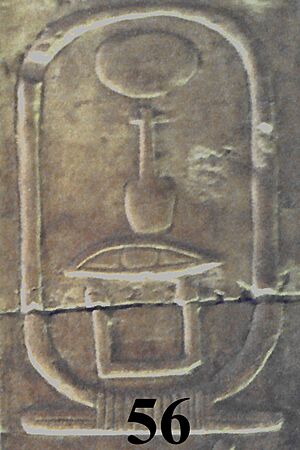Neferirkare facts for kids
Quick facts for kids Neferirkare |
|
|---|---|
| Neferirkare II | |

The cartouche of Neferirkare on the Abydos King List.
|
|
| Pharaoh | |
| Reign | 1 year and 6 months, c. 2160 BC (Eighth Dynasty) |
| Predecessor | Neferkauhor |
| Successor | uncertain; possibly Meryibre Khety |
| Burial | unknown |
Neferirkare (sometimes referred to as Neferirkare II because of Neferirkare Kakai) was an ancient Egyptian pharaoh of the Eighth Dynasty during the early First Intermediate Period (2181–2055 BC). Unfortunately, much of his story remains a puzzle, pieced together from fragmented evidence.
Some egyptologists believe he was the 17th and final king of the Eighth Dynasty. Many scholars consider Neferirkare to have been the last pharaoh of the Old Kingdom, which came to an end with the 8th Dynasty.
Neferirkare was possibly overthrown by the first king of the succeeding Herakleopolitan 9th Dynasty, Meryibre Khety. Alternatively the Egyptian state may have completely collapsed with the onset of low Nile floods, mass famine and chaos which engulfed Egypt at the start of the First Intermediate Period.

